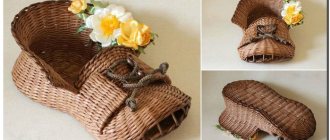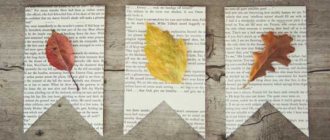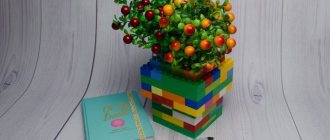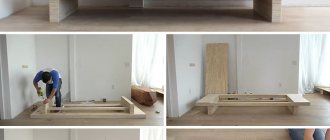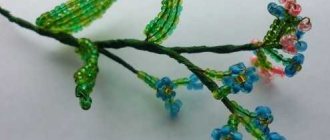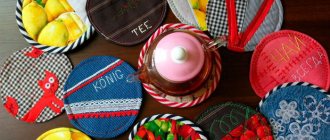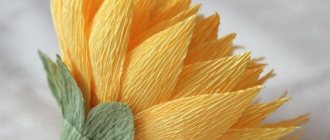History of creation
The classic nesting doll is called “a gift with a Russian soul.” Every tourist, arriving in Russia, happily brings with him such a souvenir. Its prototype is a wooden figurine of the Buddhist saint Fukurum. Initially, she looked like a sage with an elongated head. The figurine consisted of two parts, and the same sages, stacked inside each other, were hidden inside. There were five such figures in total.
According to one version, Vasily Zvezdochkin and Sergei Malyutin in 1890 turned the toy into a more understandable and cute one, creating the image of a girl, rosy-cheeked and cheerful, in a sundress and a headscarf. Having put into it that same kindness and a piece of your soul, which from generation to generation pleases the eye.
At that time, the most popular name was Matryona, which is where the name Matryoshka came from.
The classic nesting doll is made of wood and is often found on the counter of souvenir shops.
What if you need a toy now? Or so that it is not just a souvenir, but a gift made with love. In this case, try making a matryoshka doll with your own hands from different materials.
The first Russian nesting doll
The artist Milyutin met with the famous toy maker from Sergiev Posad Vasily Zvezdochkin and ordered him eight wooden blanks of different sizes that could be nested one inside the other.
Experienced wood turner Zvezdochkin coped with the task - this is how the first set of eight nesting dolls appeared. The blanks were polished, and Sergei Milyutin began painting the dolls. From the very beginning, the artist encountered difficulties of a specific nature: the colors spread over the surface, the drawing became shapeless, and he had to start all over again. It seemed that it was impossible to paint on wood, but the painter Milyutin, who had previously only used it in his work, decided to master the process of painting wooden blanks with tempera.
The water-emulsion base already made it possible to designate the pattern within certain limits, and the viscosity of the coating corresponded to the tasks set. The paints did not spread, and the artist again began painting the nesting dolls. However, a new obstacle arose; in some places the paint layer fell into the microscopic cracks of the wood structure. At this point, the color of the coating changed radically, and a dark spot appeared. Sergei Milyutin became increasingly convinced of the need to apply primer, which would level the surface of the workpiece and fill the fibrous areas of the wood.
In the end, the artist’s perseverance was rewarded, and he managed to organize painting of nesting dolls, first on an artel scale, and then within a large production enterprise.
Matryoshka made from modeling materials
Working with plasticine is quite simple and interesting for a child; other options will require the participation of an adult.
Plasticine figurine
Everything is extremely simple. We make the head and body of the nesting doll, eyes, mouth, attach plasticine peas to the body and put on a scarf.
Polymer clay figurine
- We take clay of different colors and do the same as with plasticine.
- It is better to make a flat figure, so it will definitely dry out.
- Bake in the oven for about 30 minutes. at 110 degrees. (baking time may depend on the manufacturer).
Salt dough figurine
- We form the silhouette of a matryoshka doll from the salt dough, making sure to make the figure flat.
- For relief, be sure to make an apron and a scarf, and circles on the dress.
- Bake for 10-20 minutes. at 130 degrees.
- Let the figurine cool.
- Decorate the figurine as desired.
Modeling toys from plasticine
Even a small child can make such a nesting doll. To do this you will need soft plasticine of different colors and a little patience:
Make two balls from plasticine. One ball should be larger than the other.- Connect the balls and hide the junction using the same plasticine.
- Make a small circle from white plasticine. This will be the face. And attach it to the top.
- Using yellow plasticine, create parted bangs.
- Make eyes, mouth, nose and cheeks from plasticine. Attach them to your face.
- Form a scarf from red plasticine and secure it to your head.
- To prevent the craft from falling, make a border from plasticine of any color along the very bottom.
- For decoration, you can stick flowers and decorate the nesting doll with them.
also decorate the Russian beauty with sequins, beads, and seed beads. And if you want, you can make many of these nesting dolls of different sizes.
Originally posted 2018-03-19 10:00:28.
Making a craft from salt dough
A magnificent painted nesting doll can be made not only from textiles, but also from other available materials. For example, very interesting crafts are made from salt dough. Try making such a doll with your child; modeling not only brings satisfaction, but also develops fine motor skills. So, let's discuss how to make a matryoshka doll from salt dough with your own hands. It's actually also very simple. First you need to prepare the dough. We offer you this tried and tested recipe. Take 1 glass of salt (fine, extra), 2 glasses of flour, 250 ml of cold water and mix the ingredients. Add 1-1.5 tbsp to them. l. vegetable oil. The dough for this recipe is elastic and soft. Now we make a blank from cardboard - cut out the silhouette of a nesting doll. Using a rolling pin, roll out a piece of dough into an oval shape. In this case, its thickness must be at least 6 mm. We attach a cardboard silhouette and cut out the body of the nesting doll according to it. Next we sculpt the face (small circle). A little later - handles, and then attach them to the sides of the workpiece. Using a stack we draw the eyes, mouth, cheeks. Now we leave the workpiece to dry for some time.
Final stage
After all the work is completed, you need to wait until the matryoshka is completely dry and coat the product with varnish in three layers, drying each of them.
And now, our wonderful wooden nesting doll is completely ready! Painting nesting dolls, photos of which must be left as a souvenir, will now become the best pastime for you.
Matryoshka is a Russian national doll. She is, as it were, a symbol of Russia. And when they talk about our country, the image of a nesting doll appears first. It was made back in Ancient Rus'. This doll is made of wood. It consists of two parts connected to each other in the middle. If you untwist the nesting doll, you will find another one inside it, smaller in size. Inside the second there is a third, inside the third there is a fourth, and so on. In general, one nesting doll can contain many of the same ones, but each one will be smaller than the previous one. Matryoshka dolls are made of wood and all parts of the body are painted on them and then varnished for durability. Matryoshka is the best souvenir for foreign tourists who have visited our country. Here we will draw this famous doll step by step with a pencil and then color it.
Stage 1. First, let's draw its body. Draw a large, long, elongated oval across the entire sheet of paper. Make a circle at the top of the oval. This will be the doll's face. In a circle, draw two straight lines intersecting each other at right angles. These are the lines of the eyes and nose. To draw straight lines, you can use a ruler (if you wish).
Stage 2. Now we depict the base of the nesting doll on which it will stand stably. At the bottom of the oval figure we smoothly draw two lines that remind us of a rim. This is the foundation. In the same stage, we outline the contours of the matryoshka body, starting from the sketch line of the first stage. The matryoshka has an expanded head part, then there is a narrowing and the lower part is also expanded. The figure seems to resemble a figure eight.
Stage 3. Draw the face of a matryoshka doll in a circle. We make a parting of hair and two strands, neatly laid out on the sides. At the bottom of the chin we draw a knot of the tied ends of the scarf, because at the top of the matryoshka’s face and hair there is always a scarf tied.
Stage 4. We detail the doll's face. Draw beautiful almond-shaped eyes along a horizontal line. First, the lines of the upper eyelids with eyelashes, then the lower eyelids and between them the eyes themselves with large black circles. Then on top of the eyes we make two thin lines of eyebrows, in the middle there is a small stroke - a nose and at the bottom a neat mouth made of two sponges, similar to a flower.
Stage 6. On the body of the nesting doll we draw sundress patterns. They can be very diverse and bizarre. In our case, it will be a flower. First, we draw the flower itself from petals curved up, then turned down. The result is the corolla of a flower. Then at the top of the flower we draw beautifully cut leaves.
Stage 7. Here we design the nesting doll scarf. On the sides we will also draw two halves of flowers. We must also draw handles on the sides of the doll’s body. We draw them in the sleeves of the shirt, bent at the elbows. The nesting doll has neat small hands with thin fingers.
Stage 8. Color the matryoshka doll at your discretion. Remember, nesting dolls are always very bright, colorful dolls, so don’t skimp on color to give them that unique flavor that is characteristic of this particular Russian doll.
Hi all! Today's step-by-step drawing lesson will be dedicated to the matryoshka doll!
Although the nesting doll is considered a traditional Russian toy, few people know that in fact its prototype is a Japanese doll of the cute old man Fukurokuju, a god from the pantheon of the ancient Japanese. When creating this particular doll, the principle of the matryoshka doll was applied, and in the 90s of the 19th century, the first wooden figurines depicting ruddy girls in headscarves began to be made in Russia.
By the way, the very first nesting dolls were very expensive - they were hand-painted by talented icon painters, using techniques for working with icons. That’s why the first nesting dolls have such careful depiction of faces and a characteristic color scheme. Well, we will draw the most traditional nesting doll without much detail, so an artist of any skill level can handle our lessons. It will look like one drawn on a figurine of a characteristic shape. Let's begin!
Making crafts from cardboard
This craft can be done together with your child . To make it you will need:
Matryoshka stencil.- Colored cardboard.
- Velvet colored paper.
- Scissors.
- Markers or colored pencils.
- Glue.
- A simple pencil.
- Hole puncher.
Manufacturing stages:
- Place the template on the back of the cardboard and trace it with a pencil.
- Using scissors, cut out the workpiece.
- Cut out a face in the shape of a circle from white paper and glue it onto the cardboard.
- Cut out a rectangle from velvet colored paper. Its width should match the width of the doll. Stick it on her stomach.
- Cut white strips and make holes in them along the entire length. For this you will need a hole punch.
- On one side of the strip you need to make a raised edge.
- Glue the strips to the rectangle on three sides, do not touch the top of the rectangle. It turned out to be an apron.
- Using felt-tip pens or pencils, draw parts of the face: hair, eyes, nose, cheeks and mouth.
Educational “matryoshka dolls” made of felt
I really love sewing educational toys, and you? I once found a “matryoshka-clasp” toy on the Internet, thought about it and remade it a little :) The result is a multifunctional toy, by playing with which the baby will learn basic colors, get acquainted with various emotions, and gain the skills necessary in life (the toy has 7 different clasps), recognize geometric shapes and just have fun! This is the first master class in my life, so please do not judge too harshly :) But I will listen to your suggestions and comments with pleasure! Materials: 1. Felt (for sheet size 20*30cm): - 6 sheets of white felt; - 2 sheets of red; - 2 orange leaves; - 1 sheet of yellow; - 1 green leaf; - 1 sheet of blue; - 1 sheet of blue; - 1 sheet of purple; - 1 sheet of corporal; - a piece of brown; - a piece of black (but you can save money and make the numbers brown); - a piece of light pink (it is only needed for the cheeks, so you can also use scraps of red). 2. Fasteners: - zipper (the smallest detachable zipper you can find, we need 10 cm, we’ll trim off the excess!). It’s better to take a plastic tractor, ideally with a ring dog - this is very convenient for kids to use; — Velcro 9 cm; — lace/ribbon; - if you have tools for installing eyelets, great, if not, then you need either a thin cord or a thin hat elastic for eyelets; - a 25 mm carabiner (the carabiner should open easily so that the child does not suffer later) and a small piece of tape or elastic band with a width of 20 mm; - button (from 1 to 3 pieces - at your discretion); — buttons (sew-on or magnetic, from 1 to 3 pcs.); - hook (ideally a fur coat!). 3. Consumables: - fabric markers: black, red (thin felt-tip pens will also work, the main thing is that they are indelible!), or fabric outlines (white - if available, if not - we will glue felt, then glue will come in handy, better moment Crystal); — beads/buttons are small, multi-colored.
Patterns (for the first time I converted patterns into electronic form, please do not judge too harshly):
Open it up.
We cut out the details. The result of cutting should be:
Red - the base of the nesting doll No. 7, a scarf, a square, cheeks (if you are not making pink ones) and 2 parts for sewing in a fastener (marked with a red line on the pattern). Orange - the base of matryoshka No. 6, a scarf, a rectangle and parts for sewing in a fastener. Yellow - the basis for matryoshka No. 5, a handkerchief, a circle. Green is the basis for matryoshka no. 4, a scarf and a trapezoid. Blue - the basis for matryoshka No. 3, a scarf and an oval (if you are cutting it from soft felt, it is better to cut out 2 more pieces for sewing in the fastener). Blue is the basis for matryoshka No. 2, a scarf and a rhombus. Purple is the basis for matryoshka no. 1, a scarf and a triangle. White - 7 inner parts for the nesting dolls and 7 rectangles for the reverse side (where beads or buttons will be sewn). We cut the rectangles without a pattern; these are pieces of felt with an approximate size of 2.5 * 5 cm. Leave small scraps of white felt, they can be useful for our eyes. Beige/flesh - 7 faces-circles for nesting dolls Brown - 7 hairstyles (if you cut numbers from the same felt, then 7 numbers (or black). Pink (if you didn’t use red) - 7 pairs of cheeks.
Sewing: I decorate the matryoshka doll with a zig-zag seam. I set the seam length to the minimum value and sew exactly at the junction of the parts with the base. In order not to constantly change the thread, I sew according to the following pattern: 1. I sew on the faces of all the nesting dolls (the scarf is not sewn on, but placed under the face). 2. I sew on the hair. 3. I sew on the numbers. 4. I sew on the cheeks. Don’t forget to bring the tails from the threads to the back side and secure them with a knot, then cut them off. Thus, at this stage we should have the following sewn to the white base: face, hair, cheeks, numbers. The handkerchief and figurine pocket should be placed under the face and number, but not sewn on.
Fasteners: Matryoshka No. 7 red To insert a zipper, we need a zipper - the smallest one. If the zipper is longer, cut it and carefully bend the corners. I sew in the zipper, retreating a little so that the zipper fabric sticks out, then you can be sure that the zipper will not get into the seam and stick when fastened. We sew on 2 parts of the zipper, do not forget to bend its protruding part. After this, we put a small piece on the wrong side, designed to strengthen the fastener, and sew it along the office. Since we are starting to sew with threads that match the main fabric of the nesting doll, it is at this stage that I also sew the handkerchief and pocket of the nesting doll so as not to constantly change the thread. And at the same time, we process the edges of the colored part with a zig-zag seam (this is not necessary, just a decorative seam).
Matryoshka No. 6 orange If you install eyelets: We strengthen the sides, to do this we sew parts along the edges for strengthening. We process the edges, sew on the scarf and pocket and put matryoshka no. 6 aside for now. If there are no eyelets, then we also process the edges, sew on a scarf and a pocket, and then, using a reinforcing piece, sew in eyelets for lacing (see matryoshka no. 3).
Matryoshka No. 5 yellow At this stage, process the edges of the yellow part and sew on the scarf and pocket. Matryoshka No. 4 green To install the carabiner, cut off about 7-8 cm of ribbon (or elastic band), measure 2-3 cm from the edge of the matryoshka and make a slot in the middle corresponding to the width of your ribbon. We thread the ribbon through the carabiner and insert it into this slot. We repeat the same on the other side. We adjust the length of the tape so that the carabiner closes exactly in the middle of the nesting doll. I sew it with a square, so the tape won’t pop out; we cut off the excess on the back side. Don't forget to sew on a scarf, a pocket and trim the edges.
Matryoshka No. 3 blue For loops I use either a cord or a hat elastic. We measure approximately 4-5 cm for each loop. We fasten the cut ends with thread (so that the loop does not “come apart” when sewing). We mark the location of the loops on the nesting doll at equal distances, pin the loops, apply an additional reinforcing piece and sew them together (I sew everything with a zig-zag seam). On the opposite side we sew a reinforcing piece for the fastener. We'll sew on the buttons later. We process the edges, handkerchief and pocket. If you don’t have a grommet installer, then we go back to the matryoshka doll No. 6 and make the same loops (only a little smaller in size), but on both sides of the doll!
Clasps. Matryoshka No. 2 blue I do not strengthen this matryoshka additionally. We sew the nesting doll along the edges and sew on the scarf and pocket. We will sew the buttons after connecting the white and colored parts.
Matryoshka No. 1 purple For this nesting doll it is best to use a large hook, the so-called “fur coat”. I tried to put a small, “skirt” one here - it’s difficult for kids to handle. We sew the hook itself into the edge so that the folded part protrudes slightly. I sew the loop at a distance of about 3 cm from the edge.
Drawing faces: 1. Draw a sketch. 2. Trace what you have drawn with a permanent marker. 3. Fill the eyes with a white outline (or glue white felt to size), after drying I draw the pupils. 4. Paint over the mouth with a red marker (where it is needed in the drawing) or glue red felt to size.
Creation of tactile inserts on the reverse side of nesting dolls. We cut out strips of white felt (I usually do this by eye, about 2.5 cm * 4-5 cm). We sew them on the reverse side of the colored parts. We sew beads or small buttons onto these stripes, in accordance with the number of the nesting doll.
Well, the most solemn moment is the completion of sewing! Before sewing two parts, be sure to make sure that all the pieces are stitched and the ends of the threads are hidden! We sew together the white and colored parts. For stitching I use white thread. This creates a beautiful contrast stitch on the colored part. Special attention to nesting doll No. 4! Make sure that the ribbon with the carabiner does not get caught in the stitching! What remains unfinished is Matryoshka No. 6 (if you are installing eyelets), Matryoshka No. 5, where you need to insert Velcro, and Matryoshka Dolls 3 and 2, where you need to sew on buttons and snaps. We install the eyelets in the sixth nesting doll after sewing the two parts together. Insert the lace.
Matryoshka No. 5: sew together 2 parts (white and colored, having previously sewn a piece of Velcro (equal in length to the white part) onto the white part on one side, sew the second piece on the opposite side onto the colored part.
We sew buttons, if not sewn to matryoshka no. 3, and buttons to matryoshka no. 2.
That's it, you can play! Thank you for reading!
Irreplaceable felt
Most often, soft nesting dolls are made from different pieces of fabric. The most suitable material is felt. It consists of plates of compressed wool in numerous shades. It sews and glues well, does not have a pronounced front surface. The edges of the material are not prone to fraying , so there is no need to bend them. Felt is available in different thicknesses; thicker samples can be used for the base of the doll, and thinner ones can be used for small parts.
It is better to sew the face of the nesting doll from cotton or linen fabric in light shades.
Matryoshka made from circles of colored paper
Quite a simple craft to make. To make it you will need:
- Colored paper.
- Scissors.
- Glue.
- Markers.
You need to cut out 3 circles from paper: 1 larger and 2 smaller. We roll the circles into cones. The large cone is the matryoshka sundress, and the small ones are the sleeves. These parts need to be glued together. Now you can take care of your head.
We cut out a kokoshnik or a scarf from a piece of colored paper, and draw a face on a separate white round piece. We glue these two parts and attach them to the already prepared body.
You can decorate a matryoshka doll made of paper using patterns cut out from the remains of the same paper, paste them with stickers, sequins and in general anything that suits your imagination and abilities.
Matryoshka from bottles
Would need:
- bottles of different sizes;
- gouache paints;
- scissors.
We clean the bottle from the label and wash it, remove the glue. Let it dry. We cut off the lower part and process the edges. Color it as you like and let it dry. We do the same action with the remaining bottles. To make the nesting dolls hide inside each other, we cut off the neck and also process them so as not to cut ourselves.
Painting nesting dolls
The process of painting traditional wooden dolls involves special technologies that can be divided into several parts. A matryoshka doll, the step-by-step painting of which consists of three steps: priming, painting and varnishing, requires an artistic approach, so this task is difficult for an ordinary folk art enthusiast to cope with. Otherwise, the result will resemble a popular print.
Another standard provides for a more detailed process, when the painting of a nesting doll is carried out in a truly artistic style, with the drawing of the smallest signs of the doll’s facial expressions, on which the expression of its face depends. Only a professional painter can convey Matryona’s mood, smile or sadness. Thus, a matryoshka doll, the stage-by-stage painting of which is a responsible creative process, will certainly become a work of art, and the quality of execution will directly depend on the level of training of the master. Currently, due to the high demand for traditional Russian souvenirs, enterprises producing them are increasing the pace of production, unfortunately, this affects the quality of the products.
Features of product painting
At first glance, it may seem that painting a product is not difficult, but such a judgment is considered a real misconception. The whole process is labor-intensive work in several stages. Let's look at step-by-step instructions on how to make a matryoshka doll.
The finished product (if the model is created independently) must dry thoroughly. After this, you can apply a design to it.
The drawing is a designation of the boundaries of the main elements of the painting: face, scarf, outfit, limbs.
It is recommended to start the painting procedure itself with the largest elements. To apply the material evenly, the craft should be secured with a pin driven into the board.
Paints should be used as actively as possible. A thin brush is used to draw individual elements of your craft.
After this, you can begin to design the face of the nesting doll. To begin, make some sketches using a pencil. After all the details of the face have been drawn, you can begin to cover it with acrylic varnish. All stages of design require patience and imagination from the performer. The video presents a master class on matryoshka dolls for beginners.
The resulting craft can be an excellent gift for children, adults, and especially for out-of-town or foreign guests. If you wish, you can create and paint a whole group of nesting dolls from smallest to largest. The main thing is to apply maximum imagination in the process of creative activity.
Matryoshka made from scrap materials
What should you do if your child urgently needs to bring a matryoshka doll to school, but there is neither fabric nor colored paper at home or there is very little of it?
In such a situation, improvised materials come to the rescue - cotton swabs or deodorant. To make a toy from the latter, you need:
- Deodorant bottle;
- Printed template with a picture of a doll.
- Paints;
- Two small pieces of fabric;
- Several types of glue - PVA and Superglue;
- Different types of paper - colored and white
First you need to make the deodorant look like a nesting doll, and not like a deodorant. To do this, you need to tear the white paper and glue it onto the bottle. After this, a kind of papier-mâché should be left for a day.
When the bottle is dry, you need to glue a circle of colored cardboard to the bottom, and around it the remains of white paper. Because of this, the lower part of the craft should become voluminous.
Next, the fabric is glued to the bottle. It is desirable that it be cotton with a colored pattern.
When the fabric is dry, a face is glued to the top of the bottle. You can either draw it yourself on white paper, or find a photo of a matryoshka doll on the Internet and glue it to the craft. Cheeks and lips are colored with a felt-tip pen or pencils.
The matryoshka doll is an integral symbol of Russia, so even such a holiday as the New Year cannot do without it. Make yourself a craft and enjoy!
Own workshop
The production of a popular and sought-after Russian souvenir can be organized at home. To set up a workplace you need a small table. If you have the necessary materials, painting nesting dolls at home can become an interesting creative process. To get started, you will need a set of paints, brushes, fine sandpaper and wooden blanks, which are sold in specialized stores. In addition, putty and primer will be needed to level the surface of the nesting doll. The most important rule for preparing materials is to carefully adjust the joining line of the upper and lower parts.
When turning a matryoshka doll on a lathe, the craftsmen do not make adjustments and leave the joint seam unchanged, thus entrusting the process of finishing the blanks to the craftsman who paints the dolls. Artists have to arm themselves with a file and process the protruding parts by hand. This must be done, otherwise the halves of the product will not match each other. Only when the fitting is completed, and the parts of the nesting doll are easily inserted along the joining line, can you begin painting.
After the workpiece has been sanded, it must be coated with two layers of primer. If you don’t have a ready-made mixture at hand, you can prepare the composition yourself by mixing PVA glue with water in a ratio of approximately 2:1. After the primer has completely dried, we begin painting the nesting dolls with our own hands.
For work, it is better to take acrylic paints; they are sold in an assortment in all art stores, as well as in the “Handicraft Supplies” departments. It is not necessary to buy a complete set; most of the paints will remain unused. It is better to purchase several colors that are used in the coloring process. These colors are yellow, blue, red, green and black. You will also need white and bright orange. The listed paints are universal and fit into the general style of the famous Russian souvenir.
Do-it-yourself painting of nesting dolls should begin with drawing the contours of the face, scarf, hair, sundress, apron and hands. The drawing is applied with a thin drawing pencil; bad lines can be easily removed with an eraser. All further work depends on the quality of the image, so you should take this stage seriously; it’s better to redraw it several times than to later get a crooked image in color.
Let's make a matryoshka from paper
Together with your children, you can make a funny cardboard doll. To work you will need some materials and tools:
- thick white paper A4 size;
- paints;
- scissors;
- ruler;
- glue stick;
- white cardboard;
- backing for cutting.
You will also need a computer and a printer. After preparing the necessary “consumables”, we get to work. First we print out this template.
Then we cut out the parts from paper. We apply the resulting blanks to the cardboard, trace them and cut them out along the contour.
Matryoshka made of fabric
If you have some sewing skills, you can sew a matryoshka doll with your own hands from fabric. It will be soft and quite stable.
Would need:
- scissors;
- pattern;
- beige fabric and fabric with flowers;
- cotton wool (or other filler).
We cut out all the details according to the pattern. We fold the fabric in half to make 2 parts (face-back of the head, stomach-back.) The result should be a separate head and torso. We sew the head together, leaving a hole for filling at the bottom, and draw the face. Sew the head and body together. Through the hole that remains, we fill everything with cotton wool. We put a headscarf on the doll.
You can decorate the doll with beads.
History of appearance
The tradition of the folk peasant toy called “matryoshka” was started by the Russian artist Sergei Malyutin, one of the most convinced followers of the Russian style. The painted nesting doll, carved from a single piece of wood, has become a symbol of the Russian land. The artistic depiction of a simple village woman holding a rooster in her hands and dressed in a festive outfit conveyed the full depth of the ethnographic traditions of Russia.
The principle of putting one nesting doll into another was suggested by the detachable Japanese toy “Sage Fukurama,” which was brought from the Land of the Rising Sun by the wife of Savva Mamontov, a famous Russian industrialist. Since that time, the Russian nesting doll has become a classic souvenir of world significance. A set of dolls consisting of 37 copies of “small small less” was included in the Guinness Book of Records.
Learning to form a hollow nesting doll
Traditional Russian nesting dolls are hollow. A couple of smaller dolls are “hiding” inside the large figurine. And now we will tell you how one of these figures will be made:
Materials and tools:
- plasticine;
- glass jar;
- newspaper;
- paper;
- glue;
- petrolatum;
- sandpaper;
- putty;
- water-based paint;
- brush;
- varnish;
- knife.
Description of work:
- The technology for creating a hollow nesting doll is simple. First we prepare the base for the figure. We sculpt it from plasticine or take an ordinary glass jar, but correct the shape with plasticine.
- Lubricate it with Vaseline. This little trick will later make the process of removing the mold easier and help you save time.
- On the prepared jar you need to stick several layers of newspaper or paper step by step. Then you need to wait for the paper surface to dry completely and then add a couple more layers. According to this scheme, the dummy is pasted over with pieces of newspaper in several layers. After drying, the figurine is carefully cut into 2 equal parts, and the unnecessary form is removed:
- Then the halves are connected again, as in the photo, and the “seam” is fixed using pieces of paper:
- To ensure that the workpieces “stick together” well, you can wrap them with thread while drying:
- Using this simple idea will help fix the parts in the desired position. The halves will stick together evenly and you will remove the thread.
- In order for the surface of the workpiece to be smooth, it must be treated with putty or primer. When the material is dry, you can use sandpaper to smooth out all the imperfections.
- The final stage of the MK will be painting and varnishing the figure.
There is another way to make a hollow doll. The technique is the same, but instead of a mold made from a can covered with plasticine, an inflated ball is used.
The main advantage of this idea is that the workpiece is not cut, but simply releases air from the ball and it is removed through a small hole.
Traditions in painting matryoshka dolls from antiquity to modern times
The most popular version of matryoshka painting today is called the “Sergievsky” style, named after the city where such figurines were produced. The nesting dolls from Sergiev Posad have many characteristic features, since their images have changed over time. So, at the very beginning of the 20th century, nesting dolls were painted as ancient Russian knights and boyars, and for the anniversary of the Patriotic War, dolls were even released depicting the great commanders - Kutuzov and Napoleon. Therefore, it cannot be said that this doll can only have a female face. Separately, it is worth mentioning the performances of the heroes of Russian fairy tales: characters from the stories of Pushkin, Gogol and Ershov, Krylov’s fables - all of them were embodied in wooden figurines with colorful faces. The same fairy-tale plots were repeated in the “Tver” nesting dolls, but here it is more of a tradition than a one-time execution.
It is interesting that at the same time, the “Sergiev” nesting dolls could also have additional design details - from headdresses to small objects “in the hands”. And yet, the most traditional painting of nesting dolls reflected the moments familiar to Russian people: simple life, festive and everyday images, various layers of society - from gypsies to Old Believers. You can recognize such a nesting doll by a colorful scarf, if a girl is depicted, as well as an elegant sundress and blouse with small patterns.
“Semyonovskaya” painting of a nesting doll is characterized not so much by specific details as by the selection of colors: there are always pure warm tones - yellow, red, and also often the addition of greens and blues. At the same time, the main details are outlined in black, which gives clarity to all lines. The outfit for women's and men's images cannot be festive or belong to the wealthy class - among the "Semyonovsky" nesting dolls there are only village women, in simple sundresses with floral patterns. But the scarf that always covers her head is always painted with polka dots.
The “Vyatka” painting is easily distinguished by its general image: such a nesting doll has a restrained, even shy smile, typical of a northern girl, blond hair is always with red highlights, and the eyes are traditionally blue. Clothing in pure colors, especially aprons, which always have red details. The initial samples had sundresses with thin straps, and in the hands of the nesting dolls they held a bouquet of wild flowers (certainly painted). At the same time, the painting of the “Vyatka” nesting dolls itself is dubbed by experts as flat, since they are very schematic in some way: simple blush circles on the cheeks, plain hair and clothes without highlights. There is no depth here, and the main definition that suits the toy is simplicity. In addition, the “Vyatka” nesting doll is traditionally inlaid with straws.
The Tverskaya matryoshka dolls have an interesting twist in their painting - this is the maximum liveliness of the faces. If you compare the technique of drawing the eyes, you will notice that the “Tver” toy has real, full-color and detailed eyes, while in most other nesting dolls they are barely outlined with half arches and framed by eyelashes. Even in the transitions of colors on the face, the “Tver” nesting doll wins in terms of naturalness, since here the drawing gravitates towards photography - the faces seem so real. And not only them: instead of a continuous fill, the hair is divided into separate strands and curls, and there are many folds on the scarves framing the faces.
But “krutetskaya” painting can be recognized from afar by a special technique of the first stroke, which also has an alternative name “Chinese” or “Chinese painting”. To perform it, several shades of paint are drawn onto a flat brush, after which the brush is applied and rotated in a special way: all this allows you to instantly reproduce a three-dimensional detail due to color transitions. In the “krutetskaya” nesting doll, this technique is used for absolutely every part of the product - for patterns on clothes, for hair, and even for blush on the cheeks.
Jar matryoshka using paper-plastic technique
Necessary materials:
- jar with a twist-off lid;
- ready-made papier-mâché mass;
- fine skin;
- primer;
- dye;
- brush;
- varnish;
- newspaper;
- scotch;
- scissors;
- "PVA".
Step by step execution:
- Form a head on top of the jar lid using the prepared papier-mâché mixture. If you don't know how to do it, watch the instructional video:
- Cover the jar itself, that is, the future body, with pieces of newspaper. Or cover with a thin layer of paper pulp. When the layers are dry, prime them directly on the can.
- Level the dry workpiece with fine sandpaper.
- Think in advance in what style you want to decorate your craft. Decorate the workpiece with acrylic paints, and after drying, varnish:
This nesting doll is used as decoration or an original toy and as a container for storing small parts or bulk products. It will fit perfectly into any home interior and add “charisma” to it.
